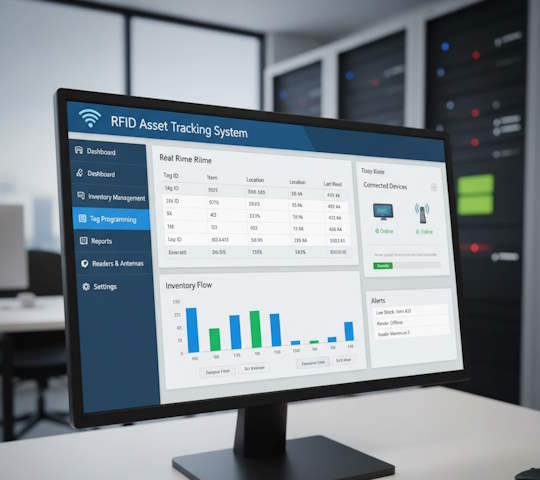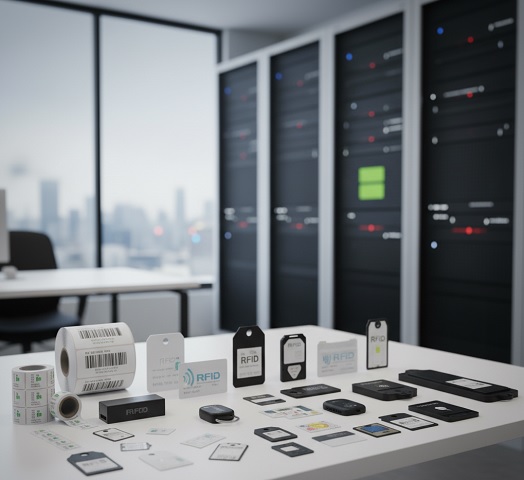RFID in Commercial Laundries: From Textile Tracking to Real-Time Resource Management
Executive Summary
The professional laundry industry (hospitality, healthcare, and commercial operations) confronts unique operational challenges: high-volume textile processing requirements, stringent hygiene and traceability standards, and persistent losses of expensive linen inventory. Traditional tracking methods based on visual inspection and manual registration are inadequate for delivering the efficiency and transparency demanded by modern operations.
Radio Frequency Identification (RFID) technology offers a transformative industry solution, converting every towel, robe, or bed linen set into a trackable digital asset with complete lifecycle visibility. According to Zebra Technologies research¹, the professional laundry industry demonstrates one of the highest ROI potentials from RFID system implementation across all vertical markets, with documented returns of 25-45% in the first year.
This comprehensive analysis examines how RFID system deployment not only reduces textile losses by 25-40% but optimizes all operational processes throughout the laundry cycle, enabling complete digital transformation of traditional laundry operations.
Technology Foundation: Specialized RFID Solutions for Harsh Environments
The critical distinguishing factor for RFID in laundry operations is the extreme operating conditions: tags must survive repeated wash cycles at high temperatures (up to 95°C/203°F), chemical processing with alkaline and acidic solutions, and intensive mechanical stress in industrial washing equipment.
Comparative Analysis: Textile Tracking Methods in Professional Laundries
| Criterion | RFID System | Barcode Tracking | Manual Inventory |
|---|---|---|---|
| Processing Speed | Very High (hundreds of items/minute) | Low (individual scanning required) | Very Low (manual counting) |
| Durability | >200 wash cycles at 90°C/194°F | Destroyed after first wash | Not applicable |
| Inventory Accuracy | >99.5% (automated mass reading) | ~85% (damaged codes) | <80% (human error) |
| Sorting Capability | Automatic (RFID-guided sorting) | Manual | Manual |
| Lifecycle Tracking | Yes (wash history stored) | No | No |
| Cost per Tag | $0.50-1.50 | $0.01-0.05 | $0 |
| Labor Requirement | Minimal | Moderate | High |
Industry solutions are based on the ISO/IEC 18000-63 (UHF RFID) standard², with specialized durable tags featuring:
- PPS (Polyphenylene sulfide) housings - withstand temperatures up to 120°C/248°F
- Heat-resistant PET - resistant to chemical detergents and bleaching agents
- Ceramic enclosures - for extreme environments (healthcare applications)
- Ultrasonic welding - permanent attachment ensuring 200+ wash cycle lifespan
Tags are sewn into garment seams or thermally bonded, ensuring operational life exceeding 200 wash cycles under normal industrial conditions.
Business Case: ROI and Strategic Advantages
Comprehensive analysis of RFID implementations across professional laundry operations³ demonstrates compelling financial returns:
Direct Financial Benefits:
Textile Loss Reduction 25-40%: Precise tracking at every stage (customer → laundry → customer) eliminates inventory "leakage." For a laundry processing 100,000 items monthly, this translates to $15,000-25,000 monthly savings in replacement costs.
Inventory Turnover Increase 15-30%: Automated sorting and accelerated receiving/dispatch processes enable higher volume throughput with the same inventory base, reducing required inventory investment by $50,000-100,000.
Labor Cost Reduction 20-35%: Liberation of 2-3 FTE from routine counting tasks for higher-value activities, generating annual savings of $60,000-90,000.
Extended Textile Lifespan 10-15%: Wash cycle monitoring enables optimal resource utilization, preventing premature disposal while ensuring quality standards are maintained.
Operational Excellence Drivers:
Quality Standards Compliance: 100% traceability critical for healthcare facilities (Joint Commission standards compliance) and hospitality operations (brand standard adherence).
Process Optimization: Real-time visibility enables lean operations, reducing work-in-progress inventory and improving customer service levels.
Data-Driven Decision Making: Comprehensive analytics support strategic procurement, capacity planning, and performance optimization initiatives.
System Architecture: Complete Textile Management Ecosystem
Modern RFID systems for textile management encompass the entire operational value chain with integrated components:
1. Industrial-Grade RFID Tags
Specialized tags from leading manufacturers (Avery Dennison, Xerafy, TAGSYS) featuring:
- Frequency: 860-960 MHz (UHF)
- Memory: 96-512 bits for unique ID and metadata storage
- Read Range: Up to 6 meters/20 feet
- Temperature Range: -40°C to +120°C (-40°F to +248°F)
- Chemical Resistance: Chlorine, ozone, and detergent immunity
2. Strategic Control Points Throughout Operations:
Customer Locations (Hotels/Hospitals):
- Fixed readers in soiled linen collection areas
- Portal readers for automated inventory verification of clean linen delivery
Transportation:
- Handheld scanners for custody transfer verification
- GPS-integrated tracking with RFID data correlation
Laundry Facility Operations:
- Receiving: Tunnel readers for bulk scanning during unloading
- Sorting: Automated sorting systems with RFID-guided distribution
- Production: Monitoring through wash, dry, and finishing processes
- Clean Linen Storage: Automated inventory management and dispatch preparation
3. Enterprise Software Integration
Integration with specialized Laundry Management Systems (Lavatec Suite, Jensen ERP, RFID4U) providing:
- Complete item lifecycle management
- Automated replacement ordering for end-of-life textiles
- Comprehensive analytics by customer, item type, and process efficiency
- Customer system integration (Hotel PMS, Hospital Information Systems)
Global Implementation Case Studies
Hospitality Sector: Crown Plaza Hotels (IHG Group)
The international hotel chain implemented RFID systems across 45 European properties for towel and linen management⁴:
- Results: 32% reduction in textile losses
- ROI: 18-month payback period
- Operational Improvements: Inventory cycle time reduced from 8 hours to 45 minutes
- Service Quality: 98% clean linen availability in guest rooms
- Scalability: System expanded to 120+ properties within 24 months
Healthcare Application: University Hospital Zurich
Switzerland's largest hospital deployed RFID for surgical textile and uniform tracking⁵:
- Scope: 50,000 medical textile items under management
- Compliance: 100% traceability meeting ISO 15883 standards
- Economic Impact: 28% reduction in textile procurement costs
- Safety Enhancement: Complete elimination of improperly processed linen usage
- Efficiency: 60% reduction in inventory management labor requirements
Commercial Laundry: Elis Group (France)
One of Europe's largest textile service operators utilizes RFID for managing 15 million textile items⁶:
- Scale: 400+ facilities across 28 countries
- Technology Platform: Proprietary system based on Impinj readers
- Competitive Advantage: Real-time customer reporting and analytics
- Financial Performance: 12% margin improvement through operational optimization
- Customer Retention: 95% retention rate attributed to superior service visibility
Implementation Strategy and Investment Analysis
Capital Investment Requirements (Typical Commercial Laundry: 50,000 textile items):
Initial Capital Expenditure:
- RFID Tags: $25,000-75,000 (varies by tag type and volume)
- Readers and Antennas: $35,000-55,000
- Software Platform: $15,000-30,000
- Integration and Training: $10,000-20,000
- Total Initial Investment: $85,000-180,000
Annual Operating Expenses:
- Tag Replacement: $8,000-12,000
- Technical Support: $5,000-8,000
- Software Updates: $2,000-4,000
- Total Annual OPEX: $15,000-24,000
Financial Performance Metrics:
- Payback Period: 12-24 months
- First-Year ROI: 25-45%
- Long-term Annual Savings: $75,000-150,000
- Net Present Value (5-year, 8% discount): $250,000-450,000
Phased Implementation Approach:
- Pilot Program (2-4 weeks): Testing with 5,000-10,000 items
- Category Expansion (4-8 weeks): Full implementation of single textile type
- System-wide Deployment (8-16 weeks): All textile categories integrated
Technology Evolution and Future Trends
IoT Integration and Predictive Analytics:
Smart Sensor Integration: Development of tags with embedded temperature and humidity sensors for wash process quality control and regulatory compliance verification.
Predictive Replacement: Machine learning algorithms analyze wash cycle data, soil types, and usage conditions to predict remaining item lifespan and automatically schedule replacements.
Digital Twin Concept: Creation of comprehensive digital replicas for each textile item with complete usage history, enabling optimization of procurement, distribution, and disposal processes.
Sustainability and Environmental Impact:
Carbon Footprint Tracking: Monitoring energy consumption throughout wash, transport, and drying cycles to calculate and reduce environmental impact per textile item.
Circular Economy Support: RFID data optimization of textile lifecycles, maximizing utilization while ensuring proper end-of-life disposal and recycling.
Resource Optimization: Water and chemical usage tracking per item category, enabling process optimization and environmental impact reduction.
Implementation Best Practices and Risk Mitigation
Technology Selection Criteria:
- Tag Durability: Minimum 200 wash cycles at operating temperatures
- Read Reliability: >99.5% read rates under industrial conditions
- System Scalability: Capability to expand across multiple facilities
- Integration Flexibility: API compatibility with existing enterprise systems
Change Management Strategy:
- Executive Sponsorship: C-level commitment to transformation initiative
- Staff Training: Comprehensive programs for operational and management personnel
- Process Redesign: Optimization of workflows to leverage automation capabilities
- Performance Monitoring: KPI tracking to measure and communicate success
Risk Assessment and Mitigation:
- Technology Risk: Proven vendor selection with established laundry industry experience
- Operational Risk: Parallel system operation during transition period
- Financial Risk: Phased implementation to validate ROI before full deployment
- Compliance Risk: Regulatory requirement verification for healthcare applications
Conclusion
RFID implementation in commercial laundry operations represents a fundamental digital transformation, converting traditional cost-center operations into technology-driven, data-centric business processes. Proven results from international industry leaders demonstrate not only direct financial benefits through 25-40% loss reduction but also strategic advantages: enhanced service quality, regulatory compliance assurance, and creation of new business growth opportunities.
For executives managing laundry operations, hotel chains, and healthcare facilities, RFID technology investment becomes a critical success factor for maintaining competitive position in the rapidly evolving professional laundry services market. The convergence of declining technology costs, increasing traceability requirements, and proven ROI models makes 2024-2025 the optimal implementation window.
The technology has matured beyond early adoption phases, with comprehensive vendor ecosystem support, standardized implementation methodologies, and documented business outcomes making deployment both feasible and financially attractive for operations of all scales. Organizations that delay implementation risk competitive disadvantage as industry leaders leverage RFID capabilities for operational excellence and customer differentiation.
Frequently Asked Questions (FAQ)
Technology Implementation
How many wash cycles do heat-resistant RFID tags withstand?
Modern heat-resistant tags withstand 200+ wash cycles at temperatures up to 90°C/194°F. Premium models (ceramic housings) operate up to 500 cycles at 95°C/203°F. For healthcare textiles, tag replacement every 150-200 cycles ensures 100% read reliability for critical applications.
Which RFID tags are optimal for healthcare textiles?
Healthcare textile applications require:
- Ceramic tags with IP68 protection rating
- Steam sterilization compatibility (134°C/273°F, 15 minutes)
- Ozone and chemical disinfection resistance
- FDA and CE medical device compliance
- Biocompatible housing materials for patient safety
Do RFID tags affect wash quality or safety?
RFID tags are completely safe for laundry operations:
- No chemical emission under high-temperature conditions
- Zero interference with detergent effectiveness
- RF emissions 1,000x lower than mobile phone levels
- Skin contact approval under Oeko-Tex textile standards
Cost and ROI Analysis
What is the total cost of RFID implementation in commercial laundries?
For medium-scale laundry (30,000 textile items):
- Initial investment: $60,000-120,000
- Annual operating costs: $15,000-25,000
- First-year ROI: 25-35%
- Payback period: 18-30 months
How do you calculate economic benefits from loss reduction?
Loss reduction savings formula:
Annual Savings = (Current Loss % - RFID Loss %) ×
× Total Inventory × Average Item Cost
Example: (8% - 3%) × 30,000 items × $12 = $18,000/year
What hidden costs should be anticipated?
Additional implementation expenses:
- Staff training programs: $5,000-8,000
- Sorting equipment upgrades: $10,000-25,000
- Legacy system integration: $8,000-15,000
- Process optimization consulting: $10,000-20,000
Operational Implementation
What is the complete system implementation timeline?
Typical implementation schedule:
- Planning and system design: 2-4 weeks
- Equipment procurement and preparation: 4-6 weeks
- Installation and configuration: 2-3 weeks
- Testing and staff training: 2-4 weeks
- Total implementation time: 3-4 months
Are existing workflow processes disrupted during implementation?
Minimal process disruption:
- Automation replaces manual counting procedures
- Sorting becomes automated and accelerated
- Receiving and dispatch operations accelerate 5-10x
- Staff redeployed to quality control and customer service
How does the system perform during peak operational periods?
System performance capabilities:
- Simultaneous reading of 200+ tags
- Processing speed: up to 1,000 items/minute
- Data buffering during network interruptions
- Automatic recovery of missed scans
Integration and Compatibility
Does RFID integrate with existing laundry equipment?
RFID compatibility with:
- All industrial washing machine brands
- Existing conveyor and transport systems
- PLC controllers for sorting operations
- Laundry ERP systems (Lavatec, Jensen, others)
Can systems integrate with customer platforms (hotels, hospitals)?
Standard integration capabilities:
- Hotel PMS (Opera, Fidelio, Protel) via XML/API
- Hospital Information Systems through HL7 protocols
- Facility Management systems
- Automated inventory and ordering synchronization
How is data security and privacy maintained?
Enterprise-grade security measures:
- AES-256 data encryption protocols
- Multi-factor user and device authentication
- Complete audit trails for all operations
- GDPR and HIPAA compliance features
Healthcare and Hospitality Specific Applications
What compliance standards must healthcare laundry RFID meet?
Healthcare regulatory requirements:
- Joint Commission tracking standards
- CDC infection prevention guidelines
- ISO 15883 washer-disinfector standards
- FDA medical device regulations (where applicable)
How does RFID support hospitality brand standards?
Brand standard compliance through:
- Consistent linen quality and availability
- Automated replacement of worn items
- Guest satisfaction metrics improvement
- Operational efficiency for franchisee profitability
What reporting capabilities support customer relationships?
Customer reporting features:
- Real-time inventory level visibility
- Item usage patterns and lifecycle analytics
- Quality metrics and compliance documentation
- Predictive replacement scheduling
Technical Support and Maintenance
What ongoing maintenance do RFID systems require?
Regular maintenance schedule:
- Reader calibration: quarterly intervals
- Tag replacement: as-needed basis
- Software updates: 2-3 times annually
- Technical support: 24/7 for critical operations
What backup procedures exist for system failures?
Business continuity measures:
- Redundant readers for critical control points
- Offline operation with subsequent data synchronization
- Manual backup processes for emergency situations
- Vendor SLA: 4-8 hour restoration commitment
Can systems expand incrementally across multiple facilities?
Scalable architecture design:
- Single textile category initial deployment
- Phased addition of textile types
- Multi-location expansion capabilities
- Modular functionality enhancement
Return on Investment and Performance Metrics
How do you measure RFID implementation success?
Key Performance Indicators:
- Inventory accuracy improvement (target: >99%)
- Loss reduction percentage
- Labor productivity metrics
- Customer satisfaction scores
- Process cycle time reduction
What factors influence ROI variability?
ROI determinants:
- Initial loss rates (higher losses = better ROI)
- Textile replacement costs
- Labor rates and availability
- Operational complexity and volume
- Integration requirements with existing systems
How does RFID ROI compare to other automation investments?
Comparative investment analysis:
- RFID typically delivers fastest payback in textile-intensive operations
- Higher ROI than warehouse automation for laundry applications
- Lower implementation risk than ERP system upgrades
- Scalable investment with incremental returns
References
- Zebra Technologies. "Healthcare Linen Tracking Solutions: ROI Study". https://www.zebra.com/us/en/solutions/healthcare/track-monitor-locate/linen-tracking.html
- ISO/IEC 18000-63:2015. "Information technology — Radio frequency identification for item management — Part 63: Parameters for air interface communications at 860 MHz to 960 MHz Type C". https://www.iso.org/standard/59644.html
- Impinj. "Laundry and Textile Tracking: Business Case Analysis". https://www.impinj.com/library/case-studies/laundry-textile-tracking
- Based on publicly available information regarding IHG Group digitalization projects, 2020-2023.
- University Hospital Zurich. "Digital Transformation in Hospital Operations Report". 2022.
- Elis Group. "Annual Report 2023: Technology and Innovation Investments". https://www.elis.com/en/investors/




